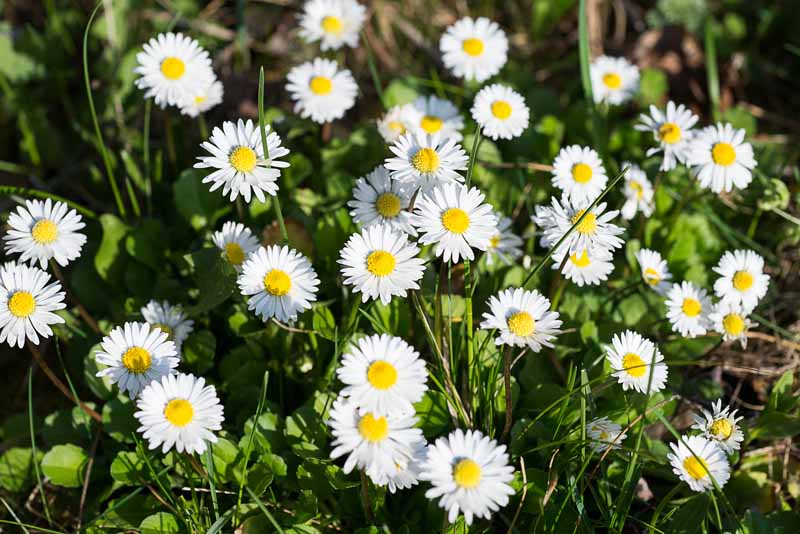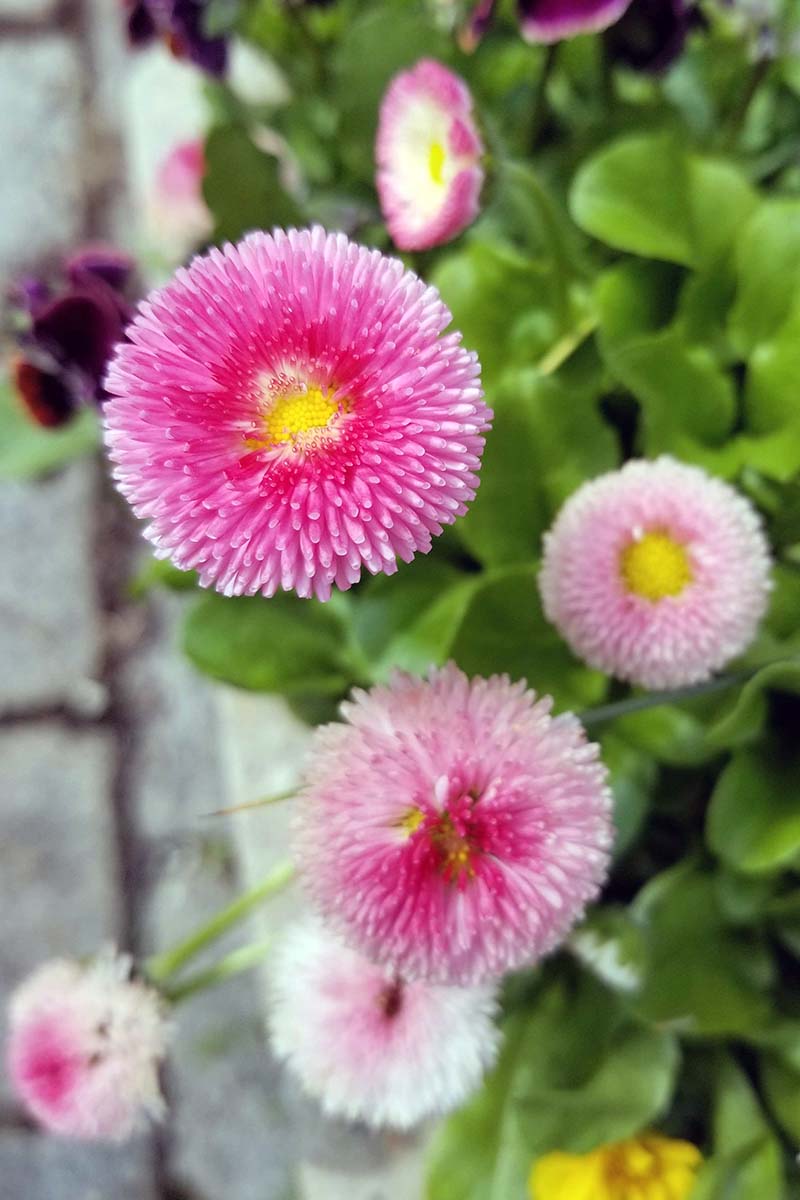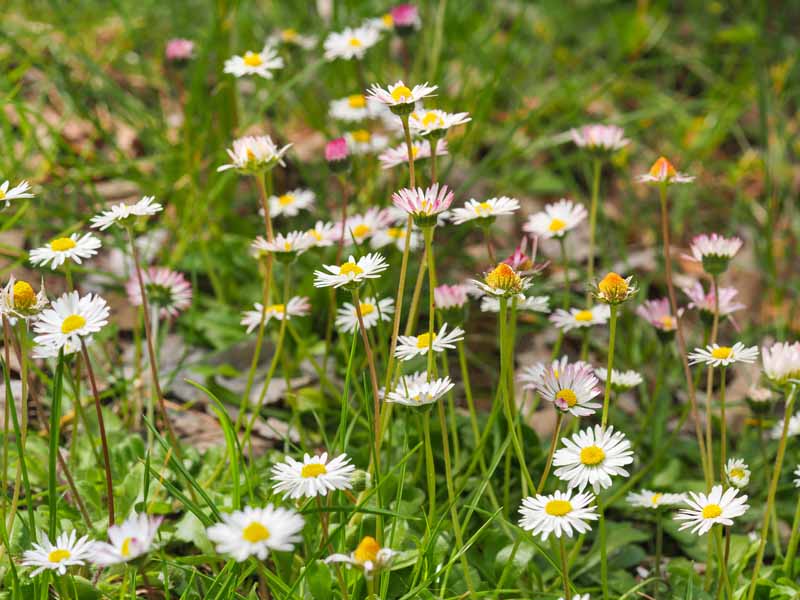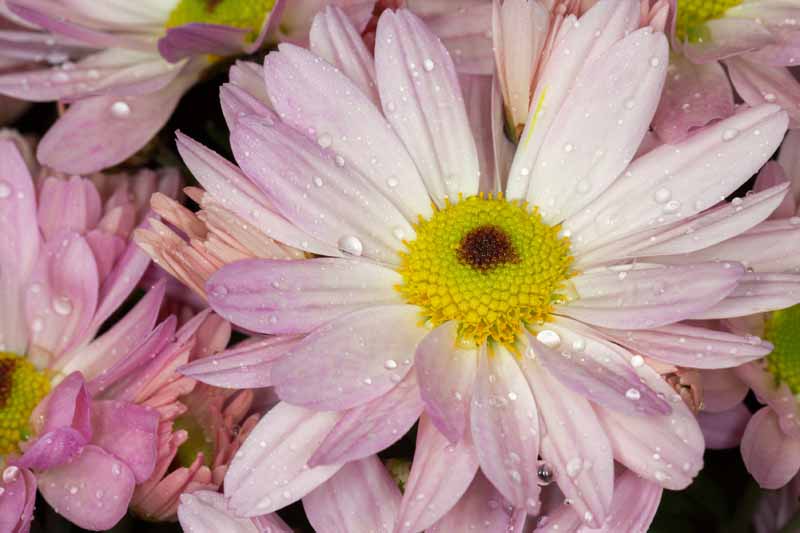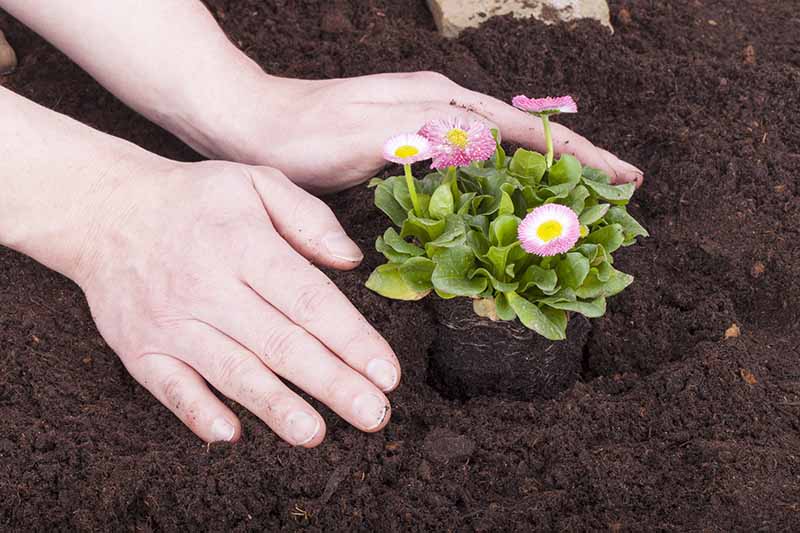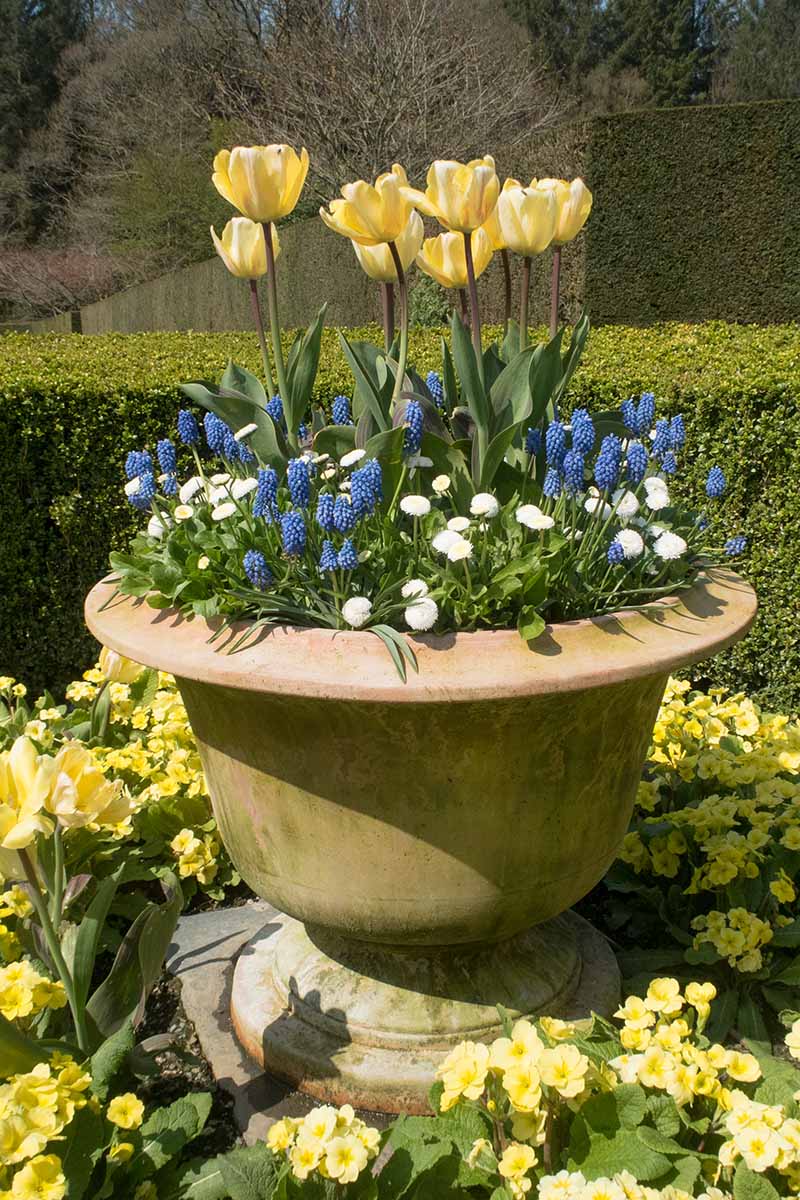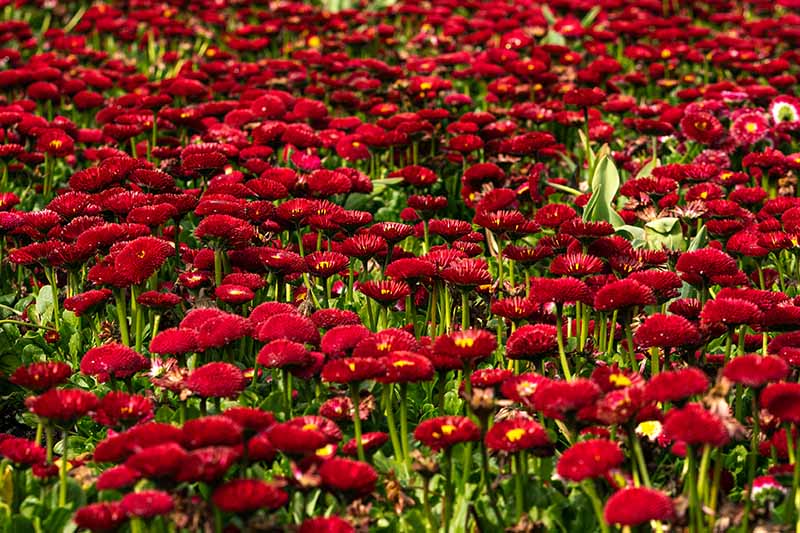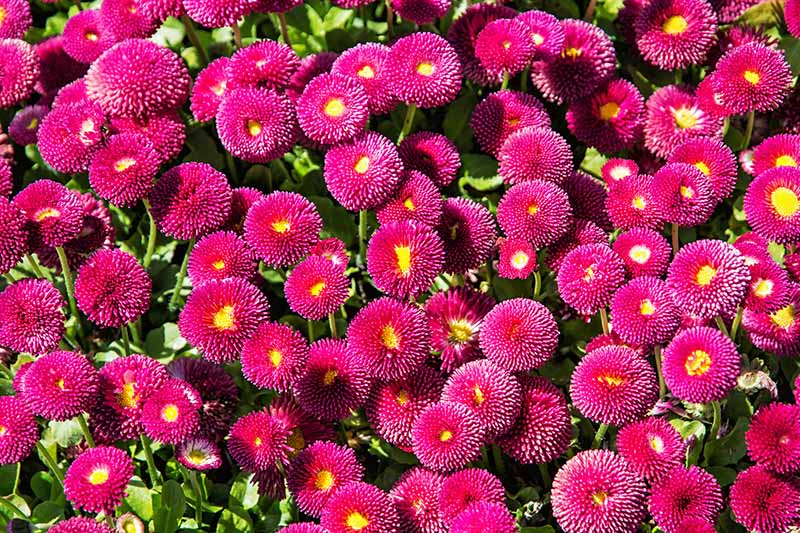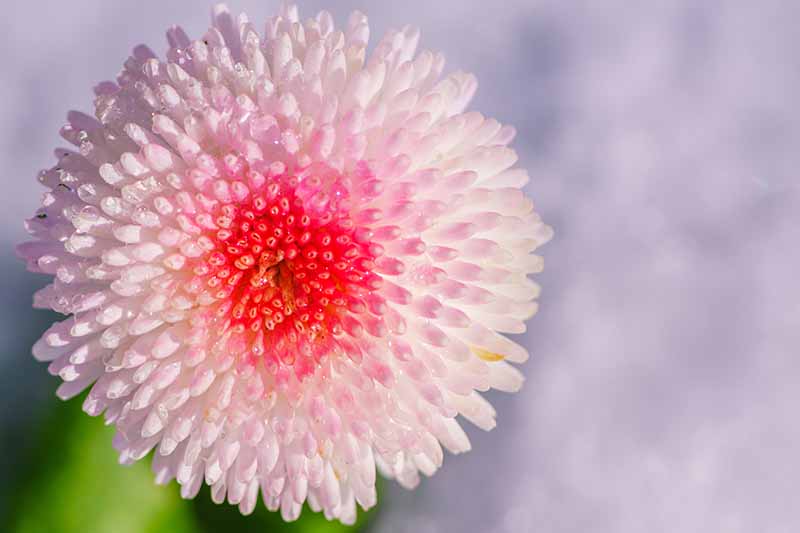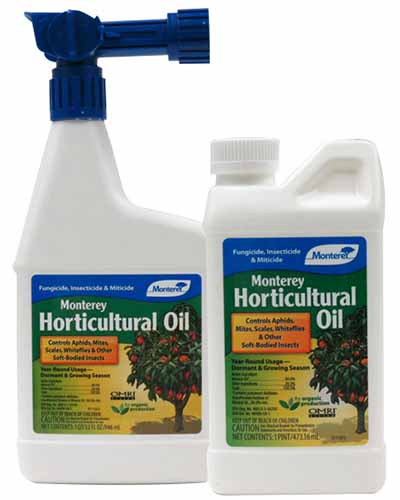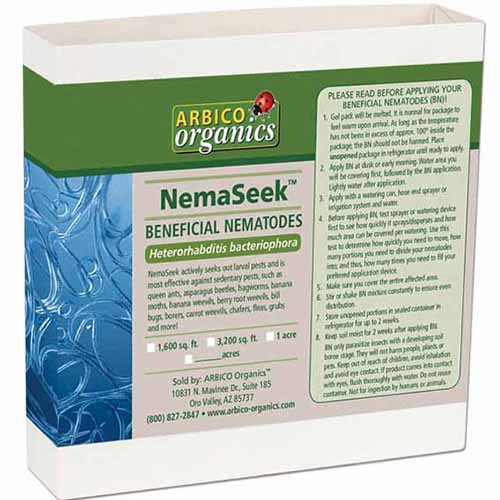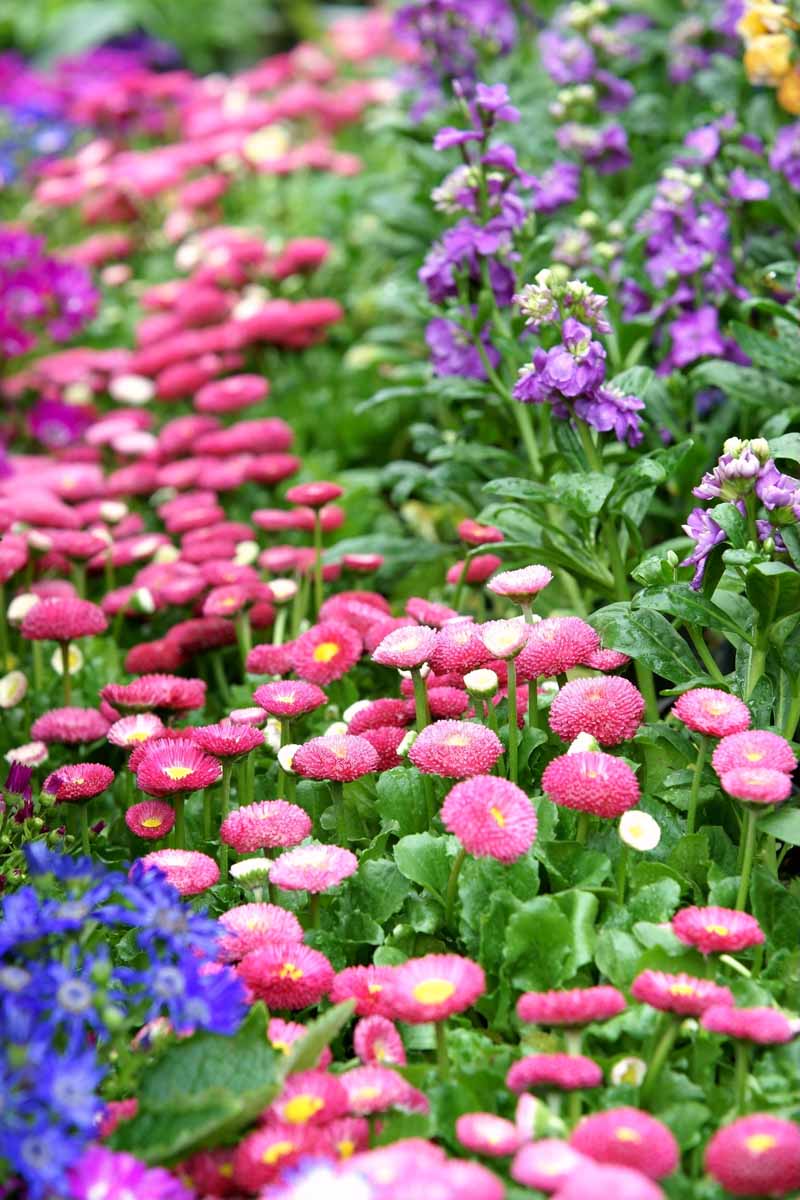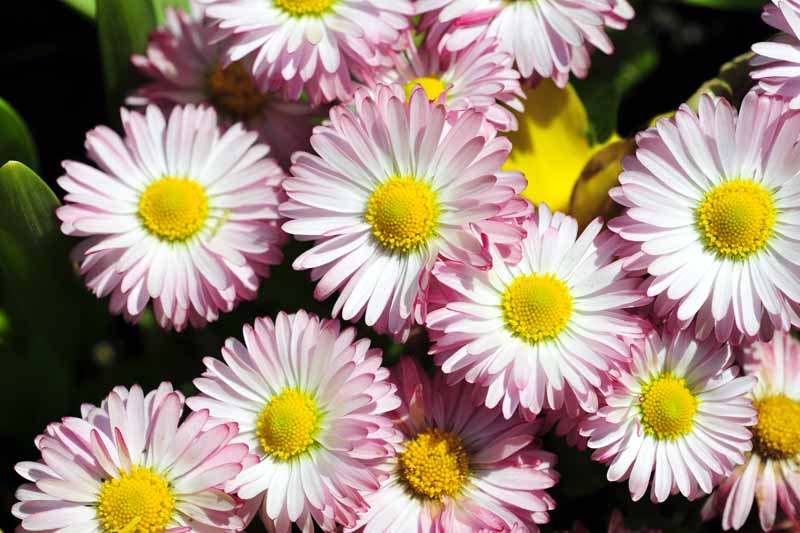And thanks to the work of plant breeders, there are a variety of colorful, full and double cultivars of the English daisy that you can grow in your garden. We link to vendors to help you find relevant products. If you buy from one of our links, we may earn a commission. Read on to learn how to grow enough of these bright flowers to make daisy chains, dry them as cut flowers, or add the edible blooms to salads and confection for days!
Cultivation and History
Hardy in Zones 3-9 and native to northern Africa, western Asia, and Europe, B. perennis is best known, strangely, as English daisy. Other names, such as common or lawn daisy, make more sense since this short plant is a familiar sight in grassy areas. Often the flower stems grow to about six inches in height, with the foliage reaching four inches in width. B. perennis translates to “pretty everlasting.” The “pretty” is self explanatory, but why “everlasting”? While these members of the Asteraceae family are naturally perennial, they are often grown as a biennial or annual, and dug up and thrown away after blooming. They also self seed easily. If left alone, they will pop up again year after year. The English daisy has been used as a home remedy to treat a variety of ailments since the Middle Ages. Administered as a diuretic and anti-inflammatory agent, it was also useful as a treatment for a variety of other ailments including coughs and congestion. Known historically as bruisewort or woundwort, leaf poultices and ointments were made by herbalists to treat wounds and bruises, and distillations were sometimes taken internally to treat liver inflammation disorders. It is rarely used as a medicine anymore today. Leaf infusions are also said to be useful as an insect repellant spray. B. perennis might look innocent, but it quickly naturalized in North America and escaped gardens to become a common weed. It is listed as invasive in Oregon, Alaska, Hawaii, and New Zealand. On the bright side, English daisy is described by the Royal Horticultural Society as a plant that is perfect for pollinators, as it attracts butterflies and others such as bees, flies, and beetles.
Propagation
English daisies can be propagated by seed, and division is sometimes possible as well.
From Seed
You can collect the seed from your own plants or let them self seed, but after a few generations, double forms can revert to single blooms. To guarantee double flowers, purchase seeds online or from your local nursery. The seeds ripen in late May to October, after flowers bloom and are pollinated. Either allow the plants to self seed, or collect the seeds yourself and sow immediately after collection. In Zones 3-7, direct sow in the midsummer to early autumn. In Zones 8-9, direct sow seeds either in the early spring when the soil is still cool, or in late autumn. The seeds need light to germinate so broadcast them on the soil surface. While direct sowing is easiest and works well, you may also choose to start seeds indoors eight to ten weeks before the average last frost date in your area. Sow on top of a soilless propagation medium in trays or individual pots. The seeds will germinate within 10 to 25 days if kept in a bright spot that is around 70°F. After germination occurs, continue to provide even moisture and when the plants are three inches tall, you can harden off before transplanting into the garden. Plants will establish roots in the first year and bloom in year two. Seed every year for an annual spring flush of flowers.
By Division
While many people grow this plant as a biennial, they are naturally perennials, so mature clumps can be divided in spring or summer after flowering. The roots are fibrous and shallow, so dig 12 inches deep and six inches out from the crown. Use a sharp shovel to cut the plant in half or thirds and replant immediately. Divided plants should show reinvigorated growth.
Transplanting
When planting divisions, seedlings, or nursery starts, amend the soil with some compost. Space the plants four inches apart and plant to the depth of the root ball, keeping the crown at the soil level. Water in well.
How to Grow
English daisies are hardy in Zones 3-9, and besides water needs, they are low maintenance. They bloom briefly during the cool spring months and their flowers disappear with the arrival of summer’s heat. They thrive in cool and moist climates, so plant in partial shade in areas with hot summers, and full sun in cooler climates. Remember that plants growing in containers tend to dry out more quickly than those growing in the ground. Feed your plants in early spring if you planted them in poor soil and didn’t amend it with compost. Use an all-purpose fertilizer such as this one from Burpee. All Purpose Granular Plant Food You can grow English daisies in containers too. Plant in porous potting soil in a container that drains well, and water generously while plants are in bloom.
Growing Tips
Plant in partial shade in areas with hot summers.Keep the soil moist.Provide well draining, rich soil.
Pruning and Maintenance
Remove spent flowers to avoid self seeding and promote repeat blooming. Like many other gardeners, you may decide to pull the entire plant out and discard it after the flowers die at the end of the season, to prevent self seeding.
Cultivars to Select
English daisies most often come in pink, red, or white, and there are multiple cultivar series available either as a mix, or with each color available individually. Breeders have developed these classic single blooms into double cultivars so full of petals the center is often nearly invisible. Here are a few of my favorites:
Bellissima Red
This cultivar produces deep rose to red flowers with a yellow center, and finishes the look with glossy green leaves. With flowers atop six-inch stems and a spread of eight inches, ‘Bellissima Red’ is an eye-popping addition to predominantly pastel-hued spring gardens.
Galaxy Rose
Part of the Galaxy series, ‘Rose’ produces large, rose-colored flowers with bright yellow centers. Plants in this series produce a dense carpet of flowers on stems six to eight inches tall, and are often used in public places underplanted with tulips, or in containers.
Managing Pests and Disease
English daisies are generally pest and disease free, but there are a few issues to keep an eye out for. The bright white blooms grow on six-inch stems.
Tasso Pink
Growing loads of beautiful frothy pink blooms on four- to six-inch-tall stems, Tasso ‘Pink,’ from the Tasso series is a gorgeous filler for garden beds and planters alike. ‘Tasso Pink’
Tasso Strawberries and Cream
Also from the Tasso series, ‘Strawberries and Cream’ grows large, dense, pom-pom shaped blooms with creamy white and rose petals, and a small red center. The flowers atop six-inch stems are gorgeous in cut arrangements, and the leaves stay a deep green after blooming. On the leaves, initial feeding tends to be on the lower leaves, and looks like rounded nibbles taken out of the leaf edge, but eventually the larvae will chew the entire leaf.
Aphids
If you are going to have an insect problem on your English daisies, it is likely to be with aphids. Monterey Horticultural Oil Stop the damage and reproduction of these soft plant-sucking, honeydew-exuding insects with a product like Monterey Horticultural Oil, available at Arbico Organics. Learn more about how to manage aphids in our guide.
European Pepper Moth
The larvae of Duponchelia fovealis can cause damage to all plant parts, including the roots. If plants are placed too close together, the larvae will also feed on upper leaves. Older larvae can chew into stems, and they will also feed on leaf debris.
Cottony Soft Rot
Sclerotinia sclerotiorum initially causes water-soaked lesions at the base of the stems. Cultural control methods include keeping the site clean by removing any dead and dying leaves, and leaving enough space between plants. NemaSeek Beneficial Nematodes Biological controls include beneficial nematodes, which may be purchased from Arbico Organics, and Bacillus thuringiensis. Naturally occurring and commercially available rove beetles (Dalotia coriaria, aka Atheta coriaria) that live in the soil also can contribute to control. You can find live rove beetles for release into your garden available from Arbico Organics as well.
Disease
English daisy is normally disease free, but in wet conditions plants may be attacked by pathogens that can cause rot. As the infection spreads through the stem, plants quickly wilt and rot. You’ll see white fluffy growth, the pathogen’s namesake, on the lesions. Since the fungi prefer wet conditions, this disease can be hard to control in the case of moisture-loving English daisy. Make sure the plants are spaced properly, and remove any diseased plants and plant parts from the garden to prevent spread.
Best Uses
These low growing, carpet forming plants can be used in bulb beds, and their bright flowers look great planted alongside tulips, buttercups, forget-me-nots, and other spring-blooming plants. Plant in drifts and clumps for bright swaths of spring color. Try adding them as a filler, or feature, in containers for your patio. Some cultivars may grow tall enough to use as a cut flower, and these flowers dry well also. Scientists today are studying extracts of the plant to determine their effectiveness for a variety of applications, including treatment of mild postpartum bleeding as well as reduction of blood glucose levels for those with type 2 diabetes. English daisies are also edible, and the leaves and flowers may be used in salads and confections. If you plan on eating any part of the plant, make sure it was grown organically and not recently sprayed with anything toxic. Besides, it’s an essential part of creating daisy chains, and who doesn’t love those? It comes in some charming shades, bringing a welcome burst of bright color after the long drab winter. Tell us about your spring garden in the comments below! What do you grow for early spring color? Will you consider adding English daisies? And for more information about growing other types of daisies in your garden, check out these guides next:
How to Grow Blackfoot DaisyColor Your Garden Brightly with Painted DaisyGrow Coneflower (Echinacea), A Native American Favorite

